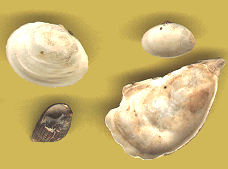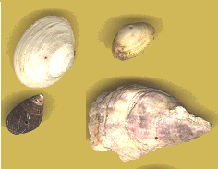|
MOLLUSK
OF LOWER SAN FRANCISCO BAY
BIVALVES
| Gemma
gemma (Totten) - Shell no longer than high, slightly triangular;
general color white with purple tinge, shell very thin, hinge and teeth
very reduced. Introduced to the San Francisco Bay from the east coast.
This bivalve is a filter feeder, meaning that it takes in water and "filters"
the algae from it to digest. It is considered a primary consumer. |
 |
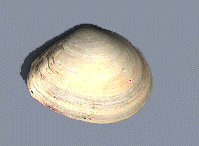 |
Macoma nasuta (Conrad) - Also called the bent-nosed
macoma.
Lives in shallow water with muddy bottoms. Some are 2 inches long, color
grayish white with thin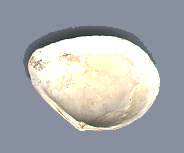 shell. Anterior end broadly rounded; posterior
end bluntly pointed, partially truncated and noticeably bent to one side
and is a filter feed like G. gemma. shell. Anterior end broadly rounded; posterior
end bluntly pointed, partially truncated and noticeably bent to one side
and is a filter feed like G. gemma. |
| Mytilus
edulis (Linne) - Shell elongated -triangular, rather plump, with
scarcely noticeable beaks at the apex. Length about 3 inches on the average.
Adult shells are deep bluish black with a shiny periostracum (outer covering);
juveniles show various shades of gray, green and brown, often exhibiting
rays of color. Also called the bay mussel, lives in rock areas in colonies.
M. edulis is a filter feeder with very few natural enemies. |
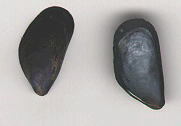 |
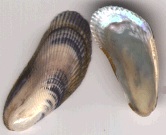 |
Iscadium
demissum - Also known as the ribbed horse mussel has fine ribbed
lines running lengthwise. This purple mussel grows to 3.5 inches. Pearly
luster inside of shell. |
| Ostrea lurida Carpenter - No longer than 2 inches, the
shape quite irregular, depending on the surface of the object on which
it grows. Shells are not especially thick or heavy. Lives in shallow waters
with stony bottoms. This is a common native oyster along the west coast
and is also a filter feeder. |
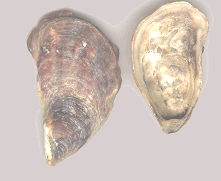
|
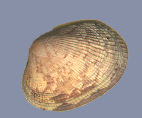 |
Tapes
japonica (Deshayes) - Also called the Japanese Littleneck clam is
about 2 inches long. It is an introduced species from Japan. It has ribs
with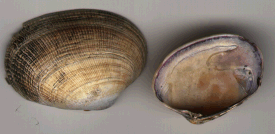 yellowish gray color in a chevron pattern, running up and down their
shell. yellowish gray color in a chevron pattern, running up and down their
shell. |
GASTROPODS
| Ocenebra interfossa (Carpenter) - A spindle-shaped shell
about 3/4 of an inch high. There are 5 whorls, high spiral, and a sharp
apex. Lives in the shoreline or on rocks. Commonly called the sculptured
rock shell, because of the large wavy ridges that revolve with the whorls.
This little gastropod is top of the food chain in the mud, eating many
of the bivalves and other gastropods. |
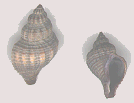
|

|
Nassarius obsoletus (Say) - Black Dog Whelk; medium sized,
surface blackish with obscure spiral and longitudinal lines, introduced
and extremely abundant in the San Francisco Bay (mud snail), nearly one
inch high, with about 6 whorls. Apex rather blunt, and commonly more or
less eroded. The only sculpture consists of weak revolving lines, plus
a few vertical folds on the early whorls. Inner lip deeply arched. Color
deep purplish black. This is an east coast snail, probably introduced into
California water with young oysters. It is a scavenger that eats dead fish
or other organic debris. |
| Nassarius
tegulus (Reeve) - Commonly called the Mud Dog Whelk. Lives in the
mudflats, about 3/4 of an inch high, a stocky shell of 5 or 6 whorls with
a sharply pointed apex. Sculpture of weak revolving lines, sometimes faintly
banded. Inner lip broadly expanded, outer lip thickened. This group eats
similar to N. obsoletus and is hard to distinguish between the two. |
 |
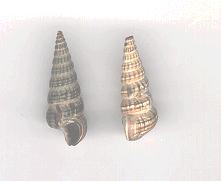 |
Cerithidea
californica Halderman - Greatly elongated, with approximately 10
rounded whorls. Sculptured with vertical ribs and revolving ridges, aperture
open. Color is brown. Shell is approximately 1.5 inches high. A large group
of organisms that live mainly in tropical waters. A few will venture into
the San Francisco Bay, but this group is very rare. This groups eats similar
to N. obsoletus. |
Acmaea
digitalis Eschscholz - Finger Limpet is the common name for this
species. Color is gray with stripes, specks and blotches of brown and white.
Dark brown to black border at rim. Shells conical, oval, and open at base,
with no opening at the top. No spiral at any stage of growth and does not
have the pearly look to its inside shell. They live on stones and grasses
at the shoreline, generally between the tide limits. They are herbaceous
which means they eat small algae or bacteria. |
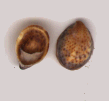 |
HOW
CAN WE TELL WHO EATS WHO?
Notice the tiny little round hole that
are in each of the shells above. This is where a carnivore (usually a gastropod)
drills into the shell and then "sucks" its dinner out. One of the gastropods
above has also been punctured. Another species of gastropod can feed on
another species.
|


 shell. Anterior end broadly rounded; posterior
end bluntly pointed, partially truncated and noticeably bent to one side
and is a filter feed like G. gemma.
shell. Anterior end broadly rounded; posterior
end bluntly pointed, partially truncated and noticeably bent to one side
and is a filter feed like G. gemma.



 yellowish gray color in a chevron pattern, running up and down their
shell.
yellowish gray color in a chevron pattern, running up and down their
shell.




